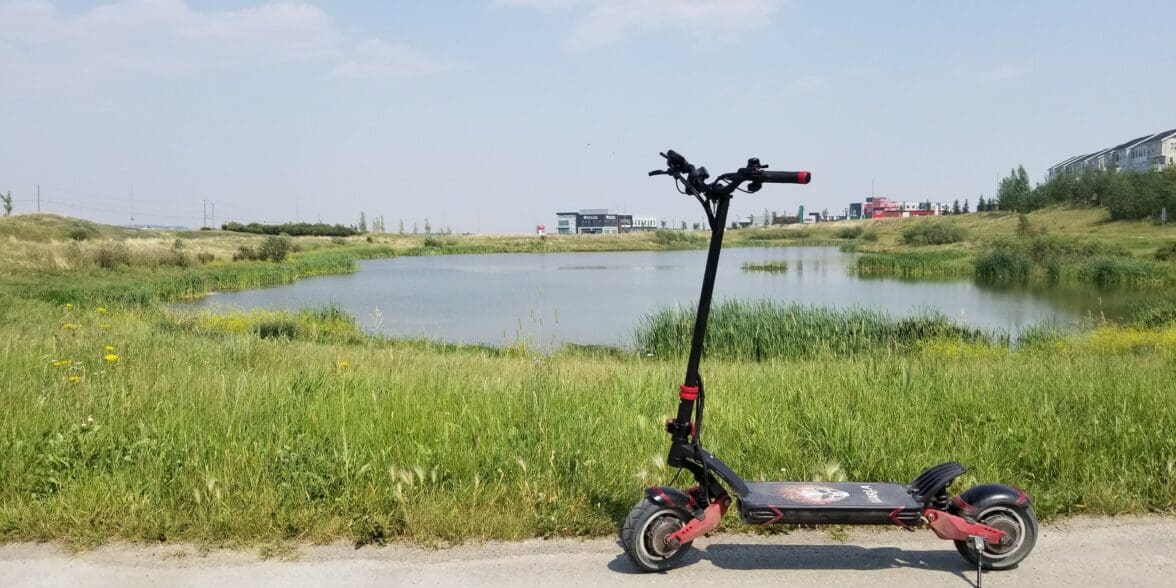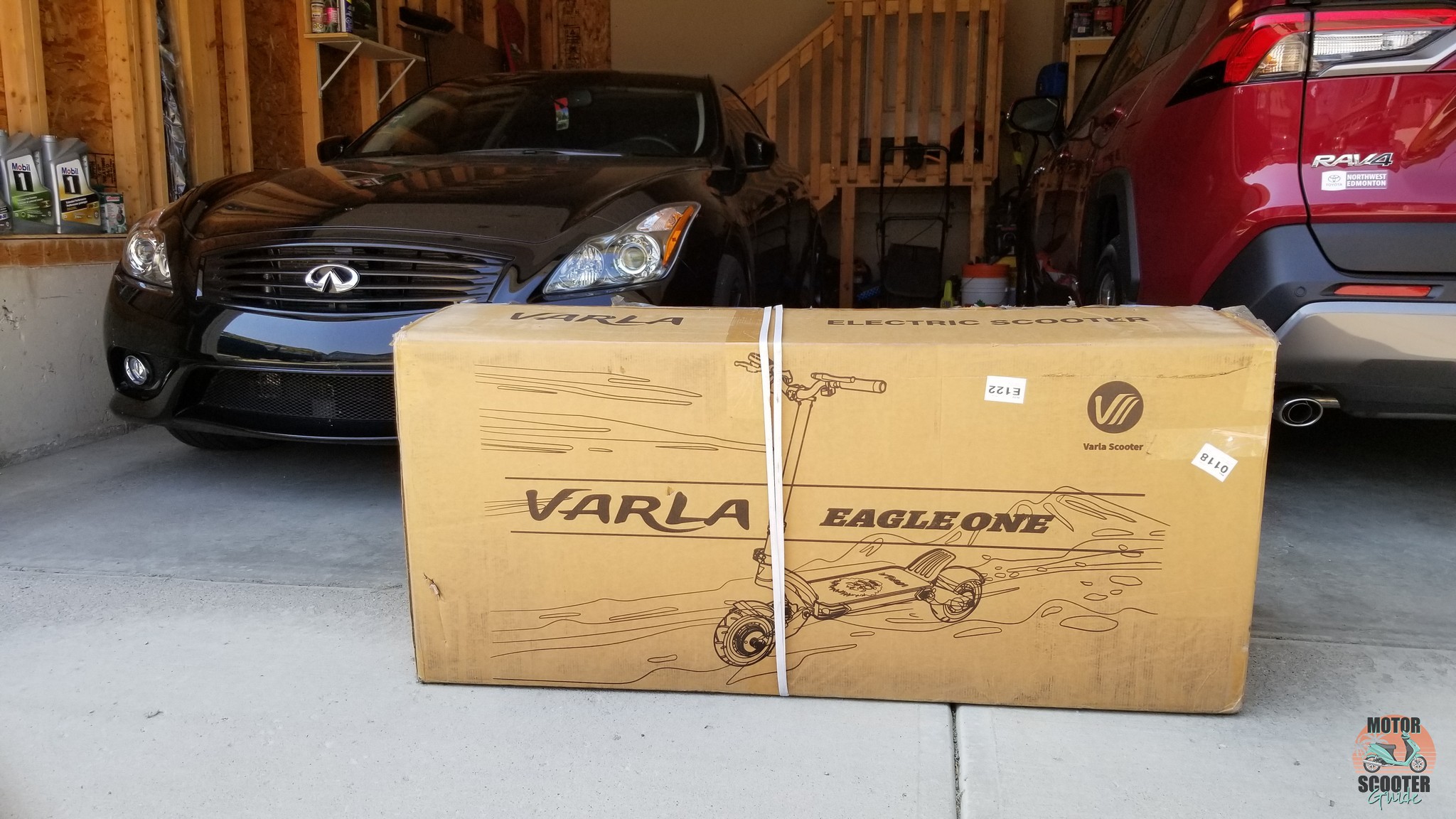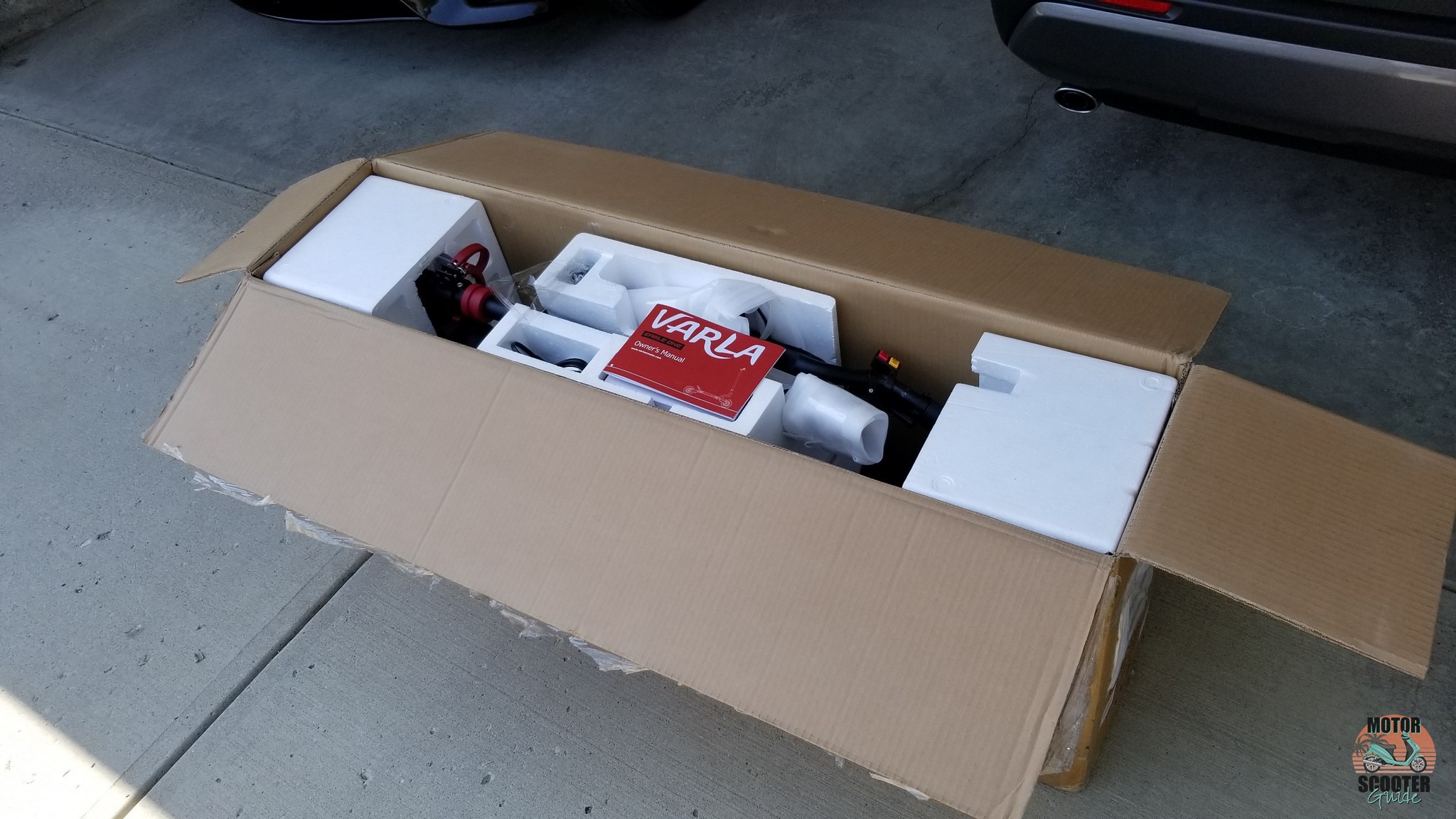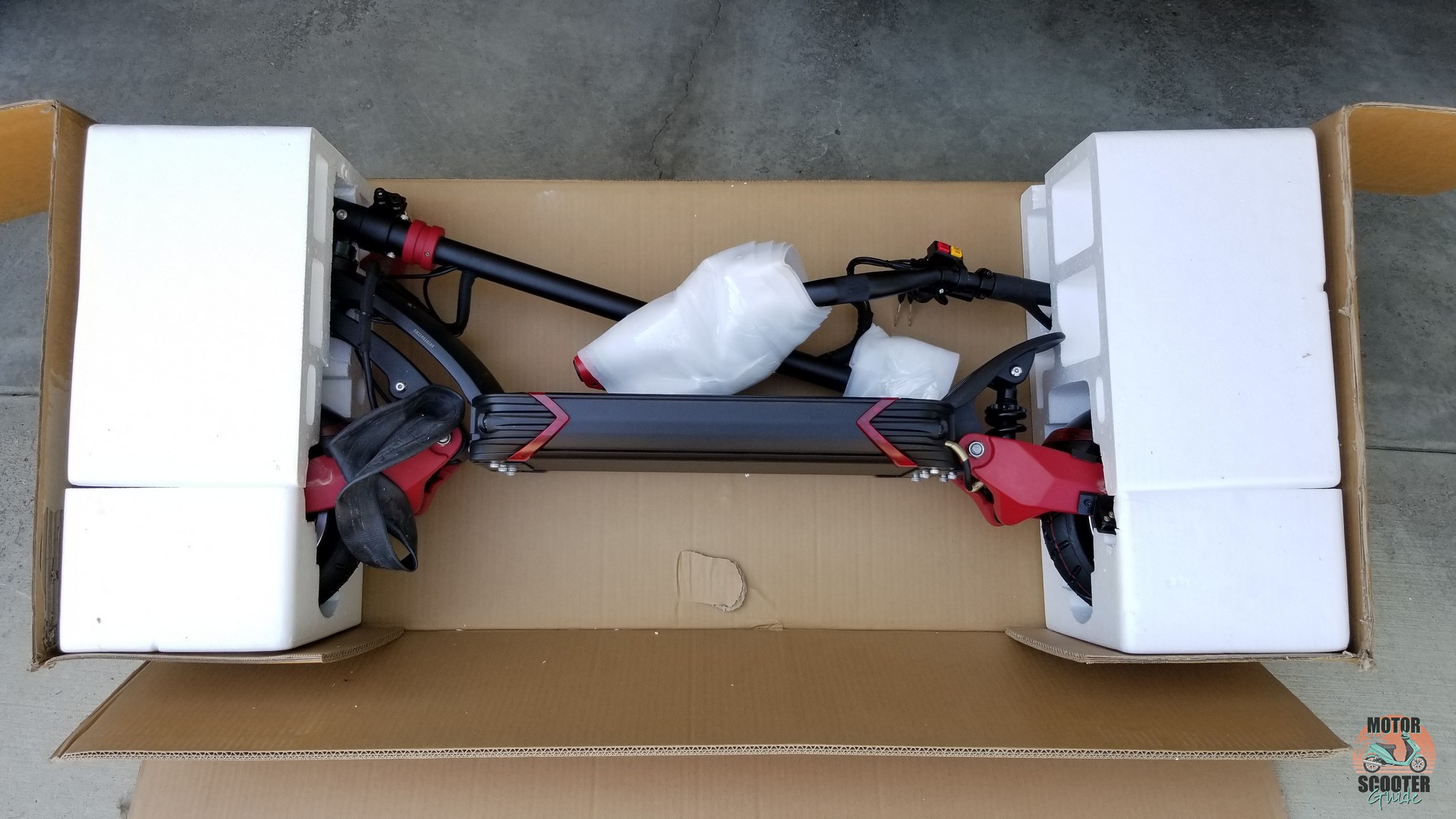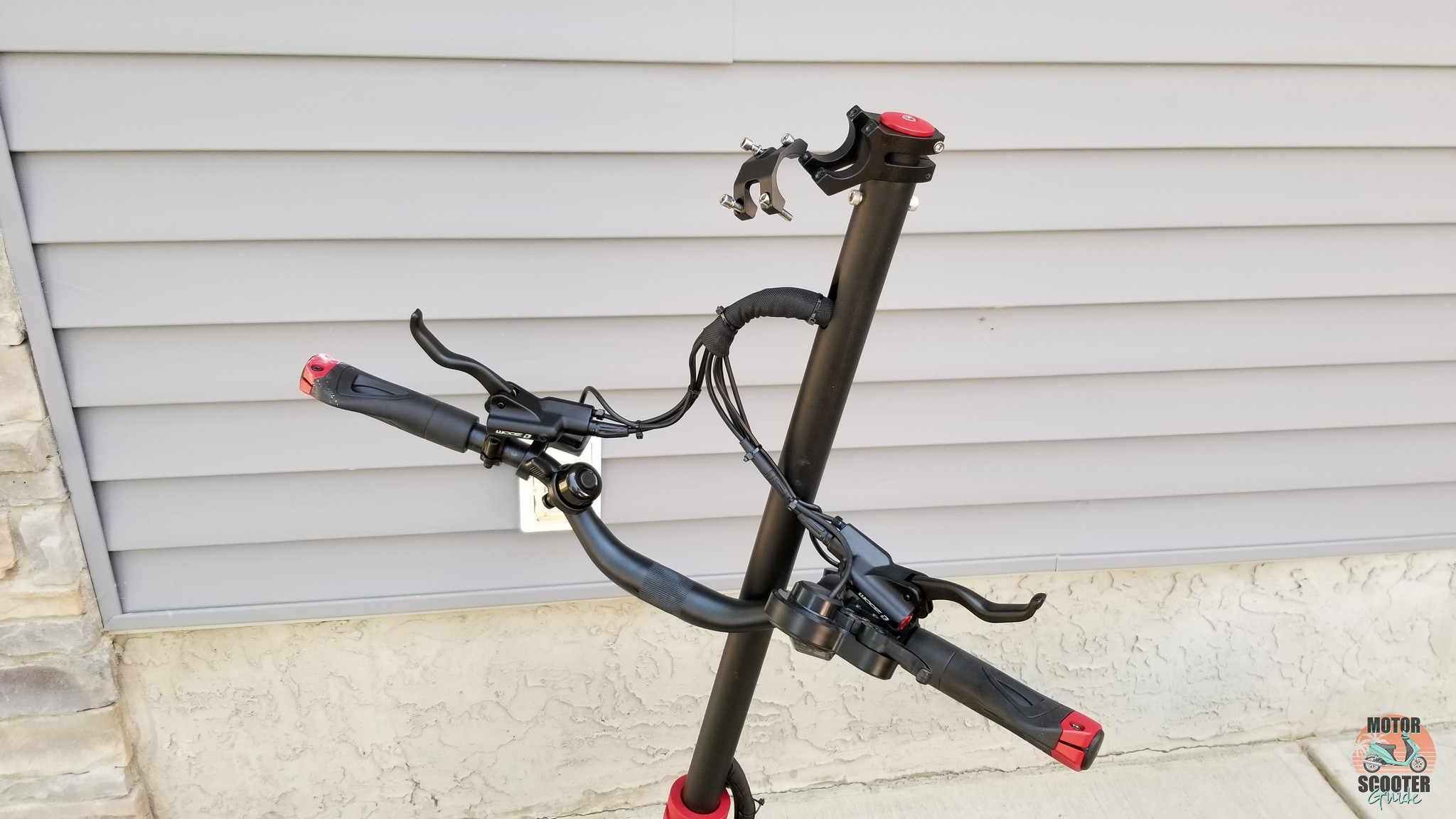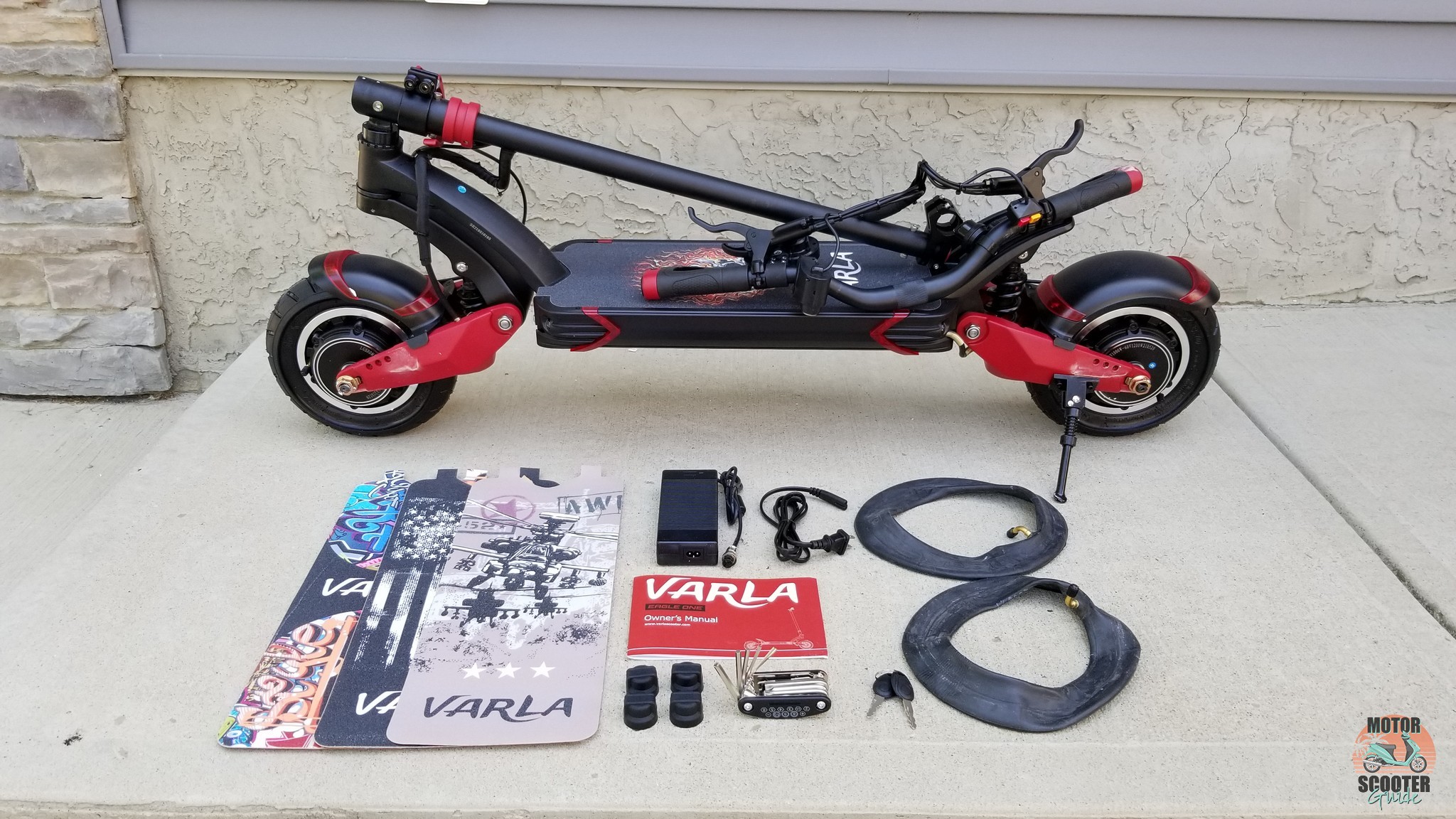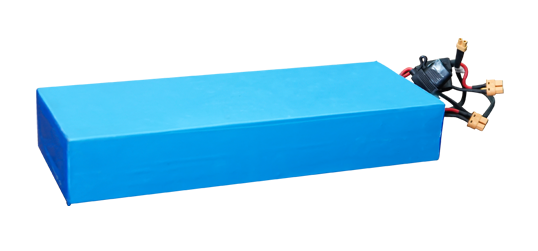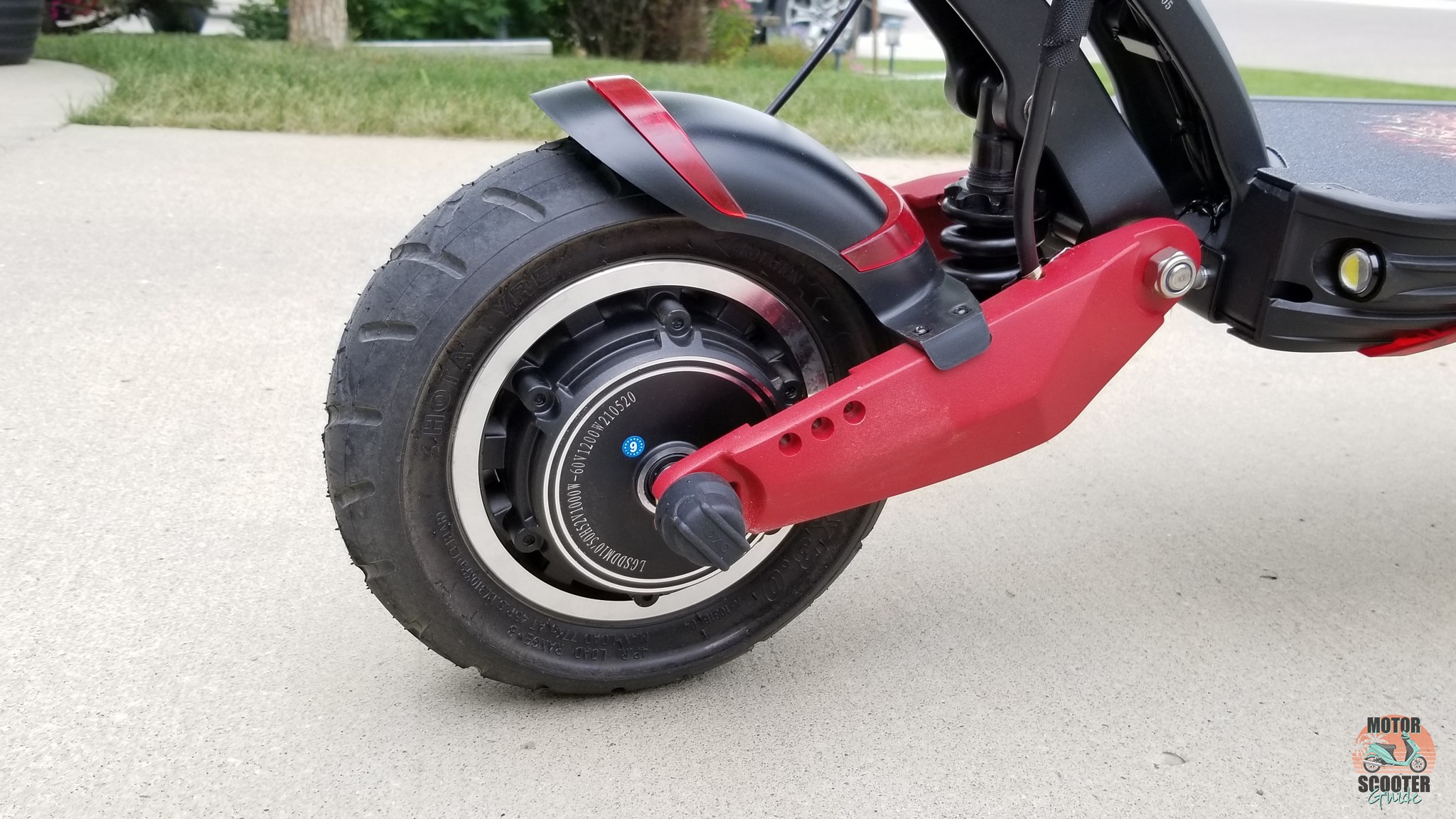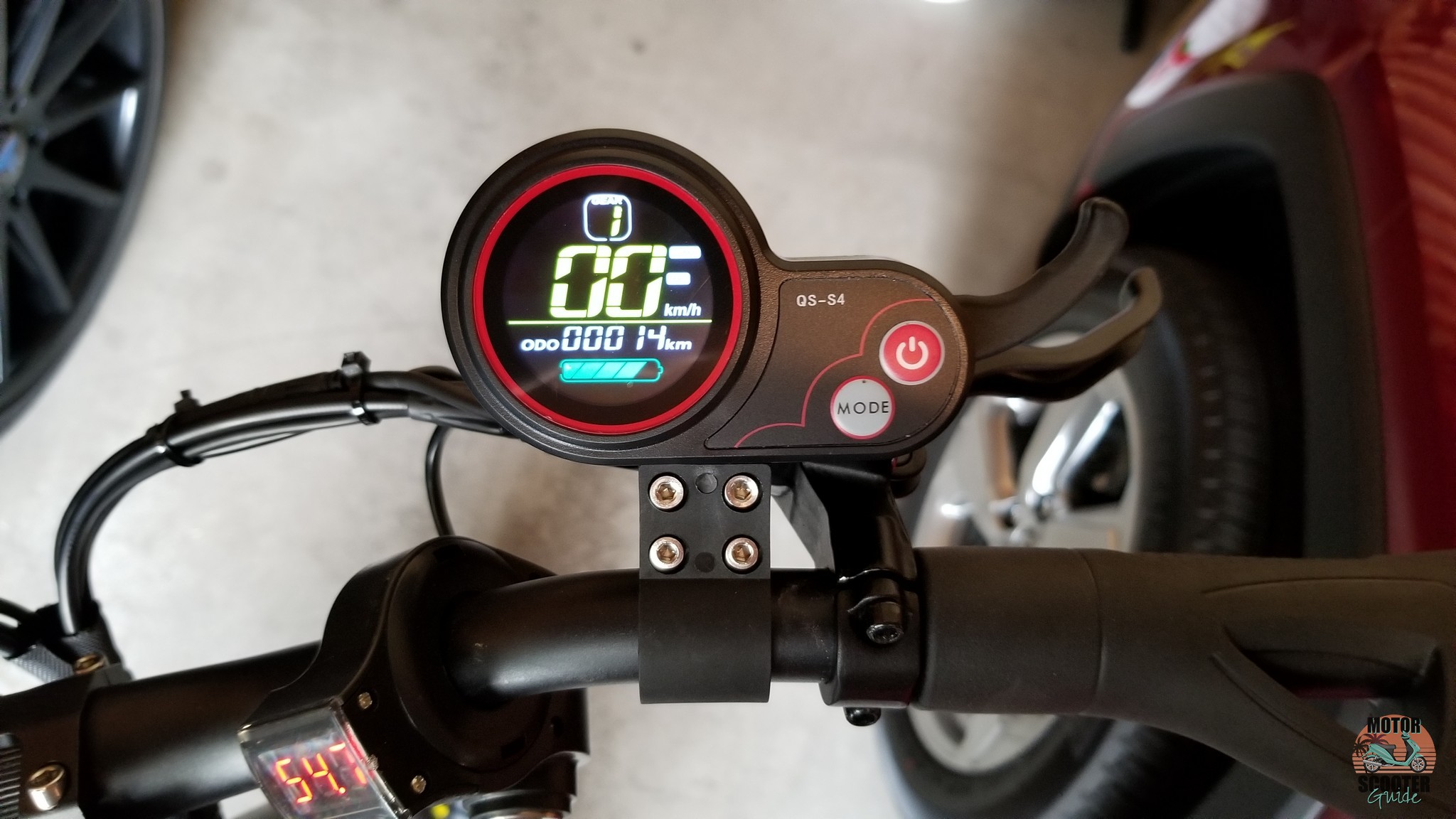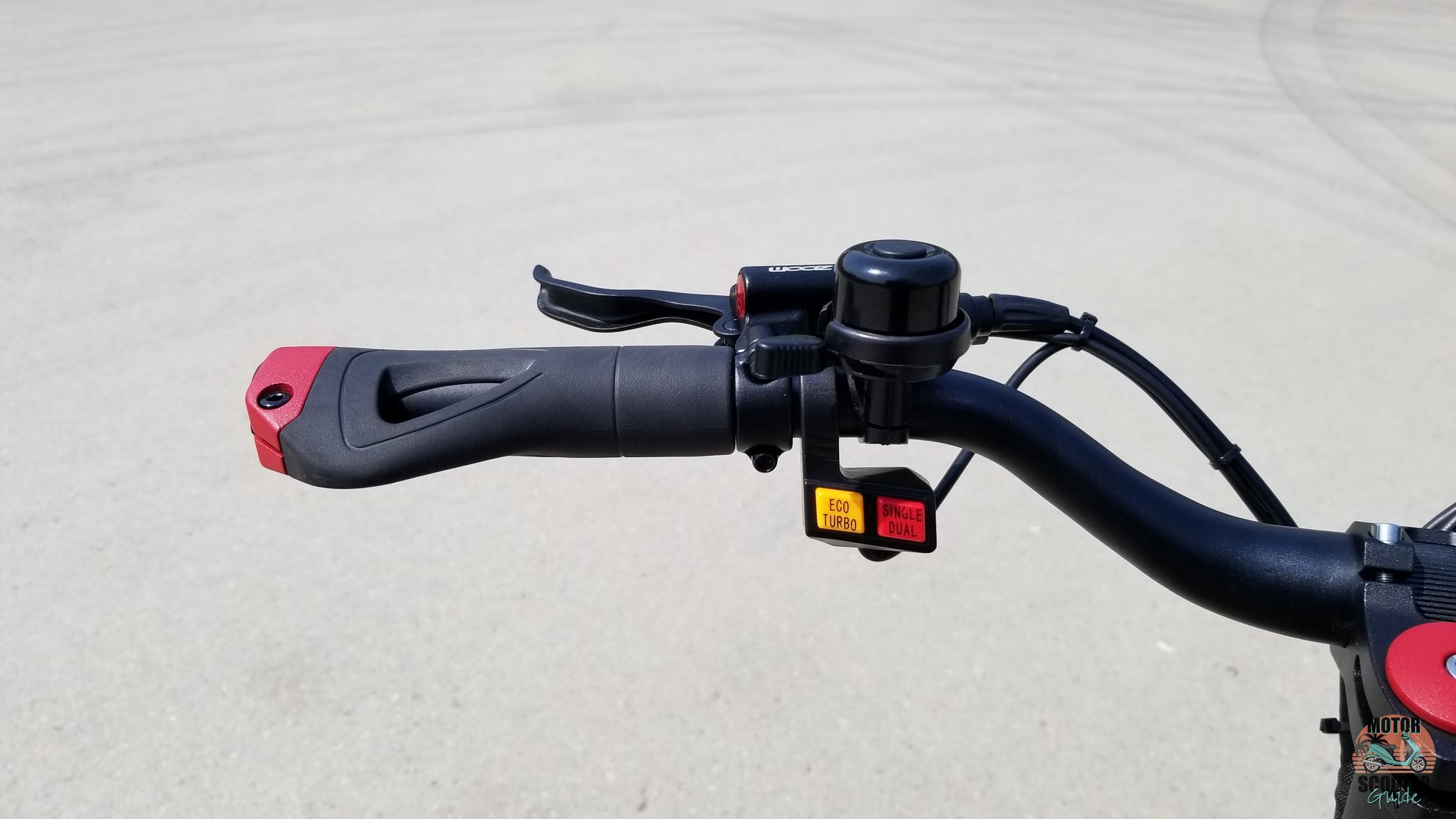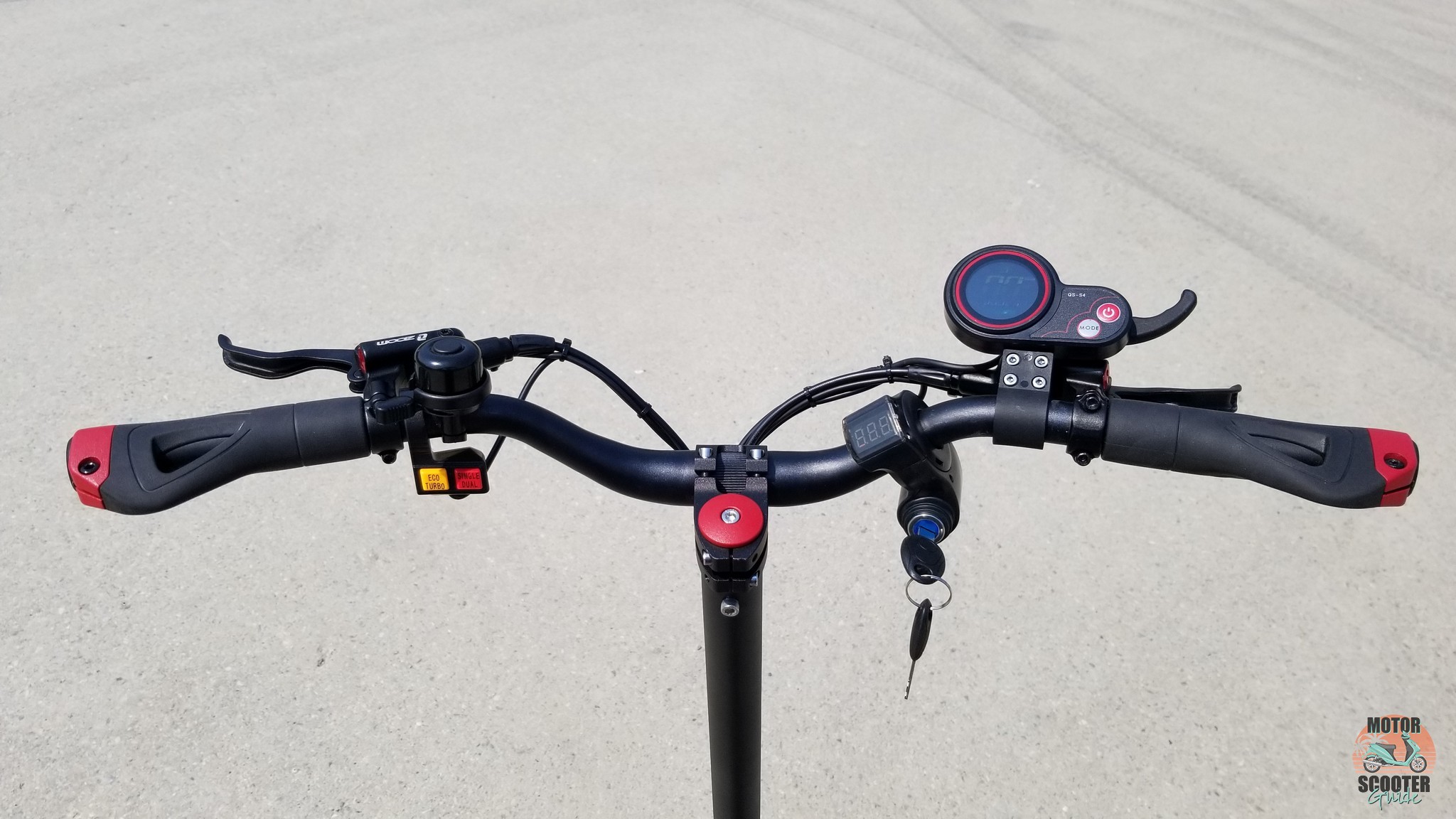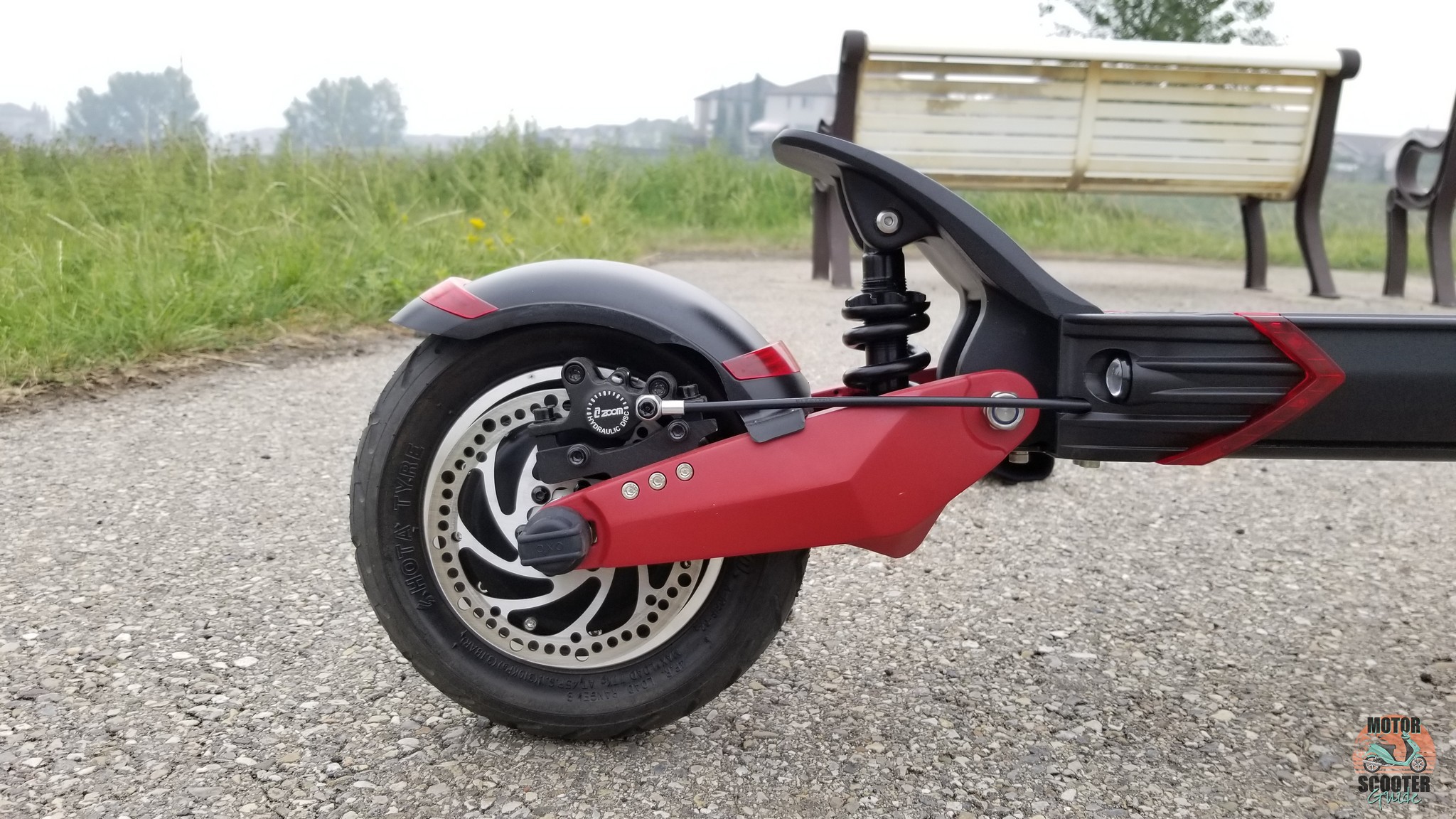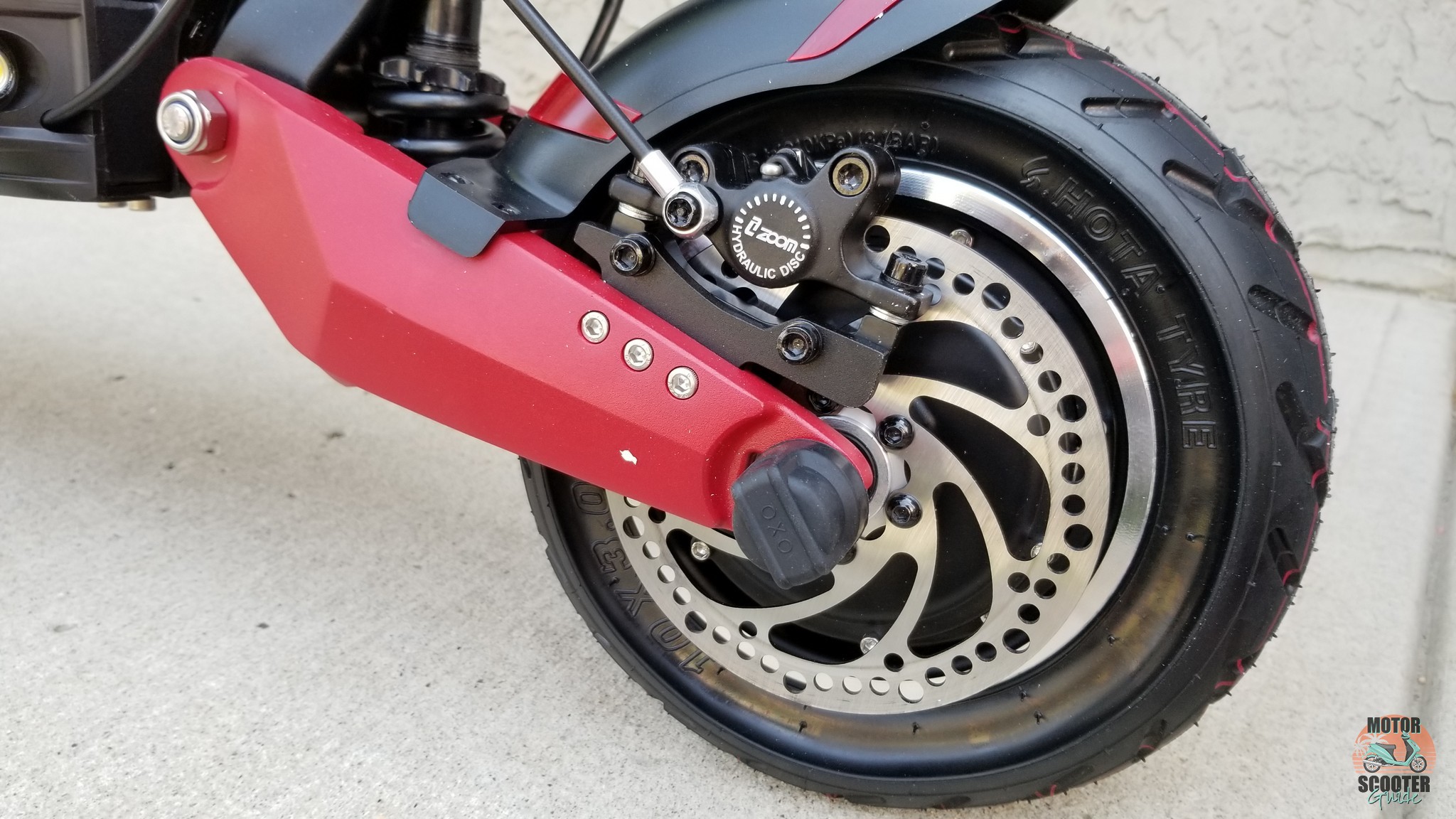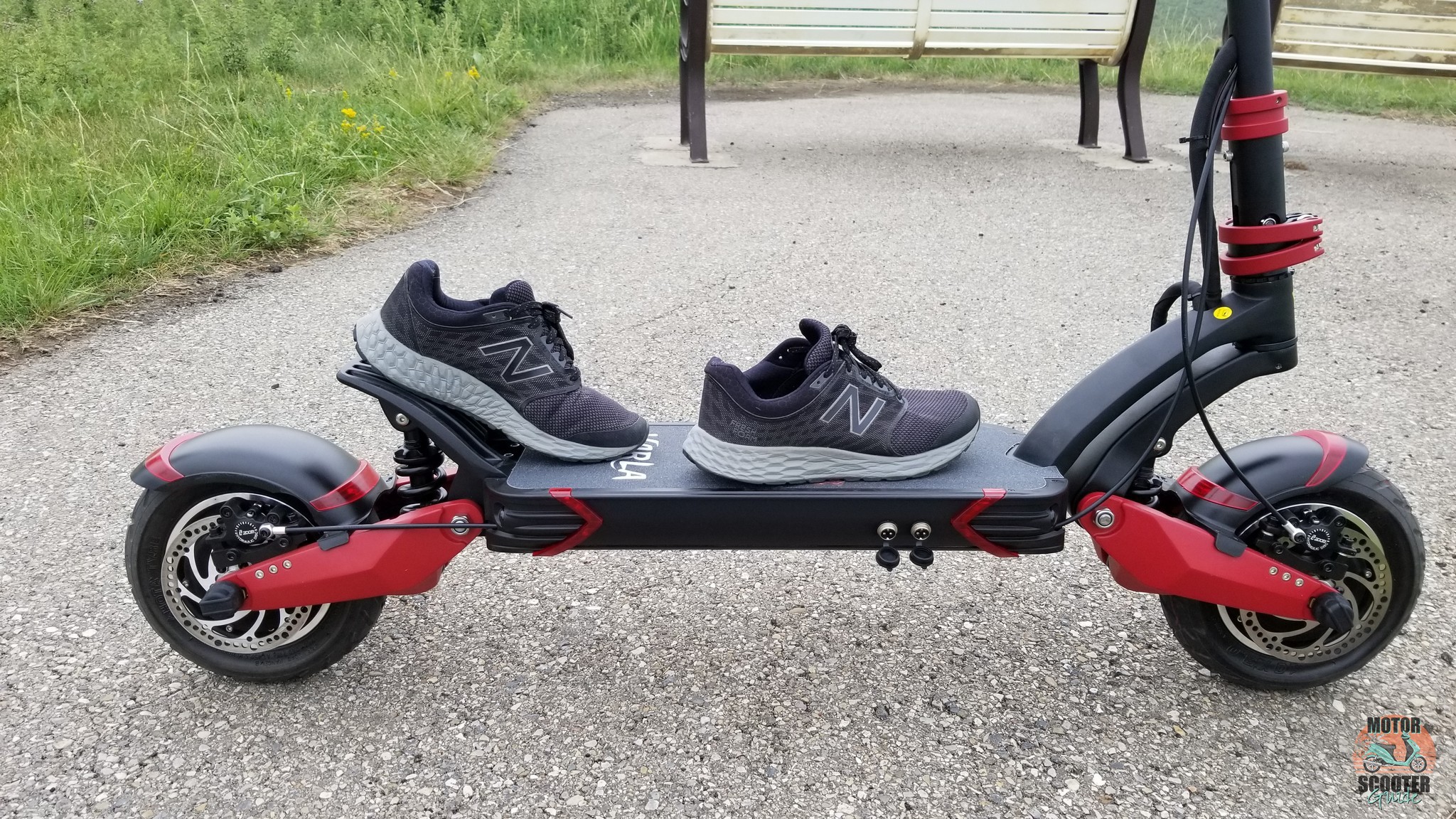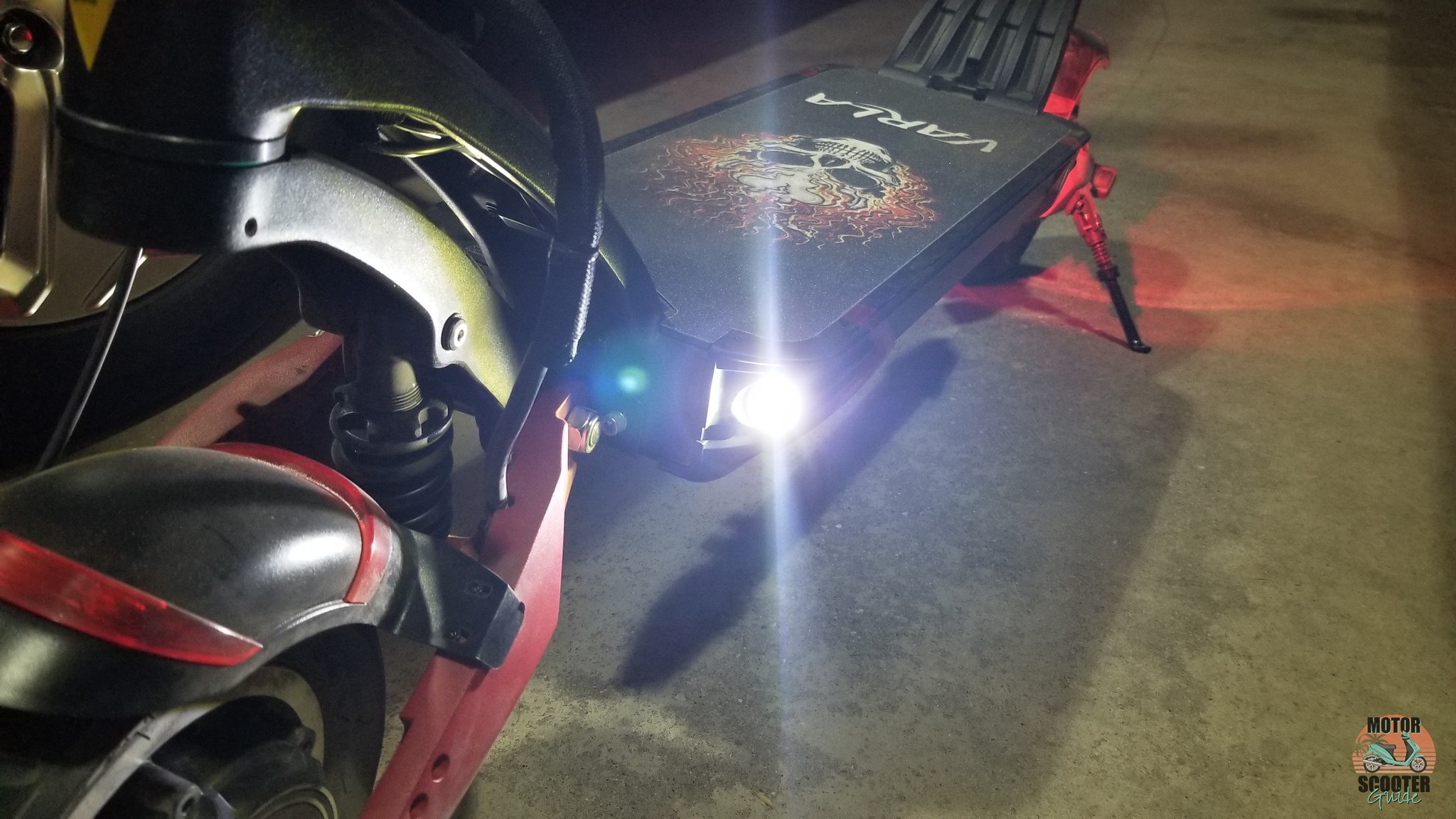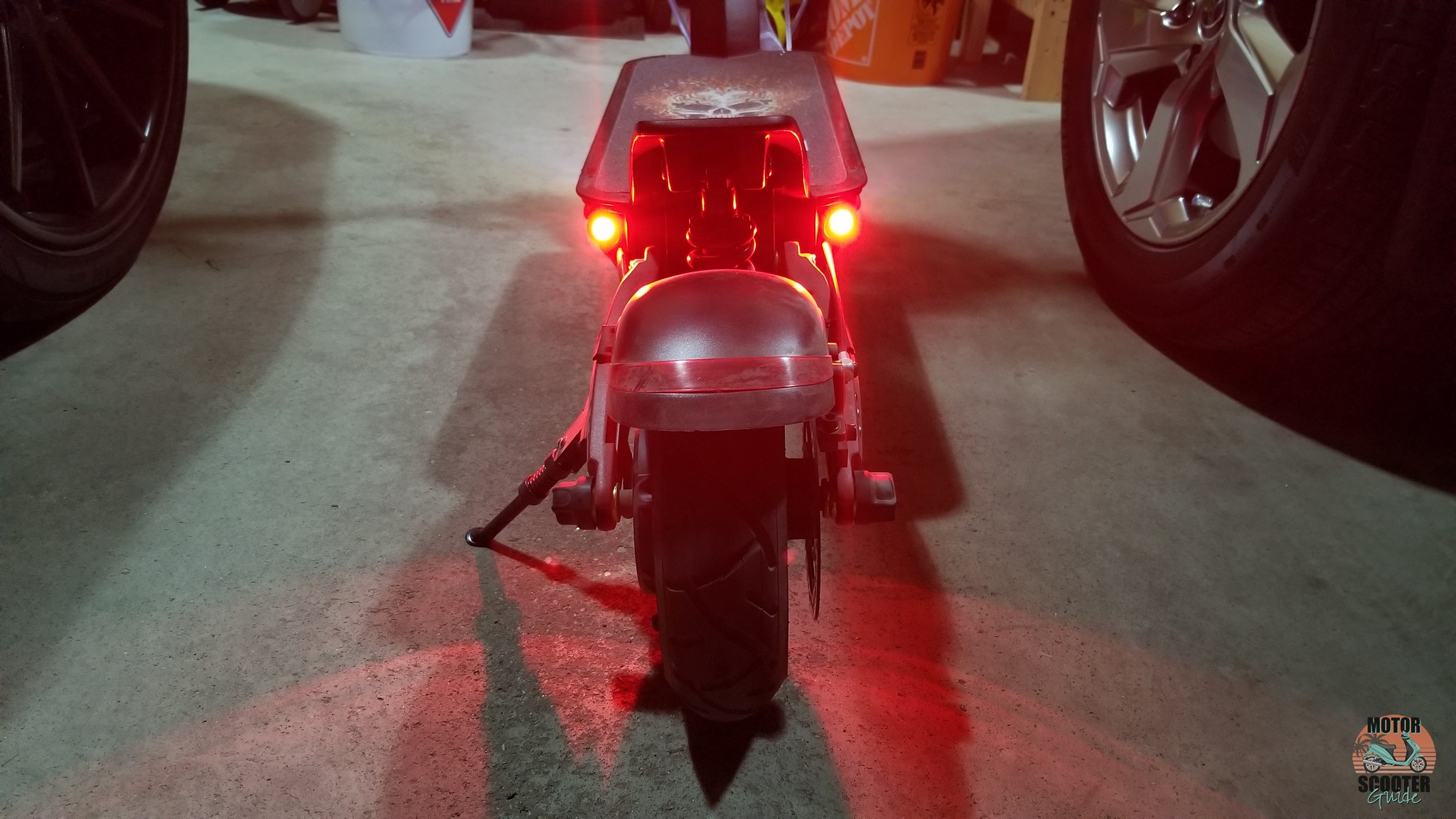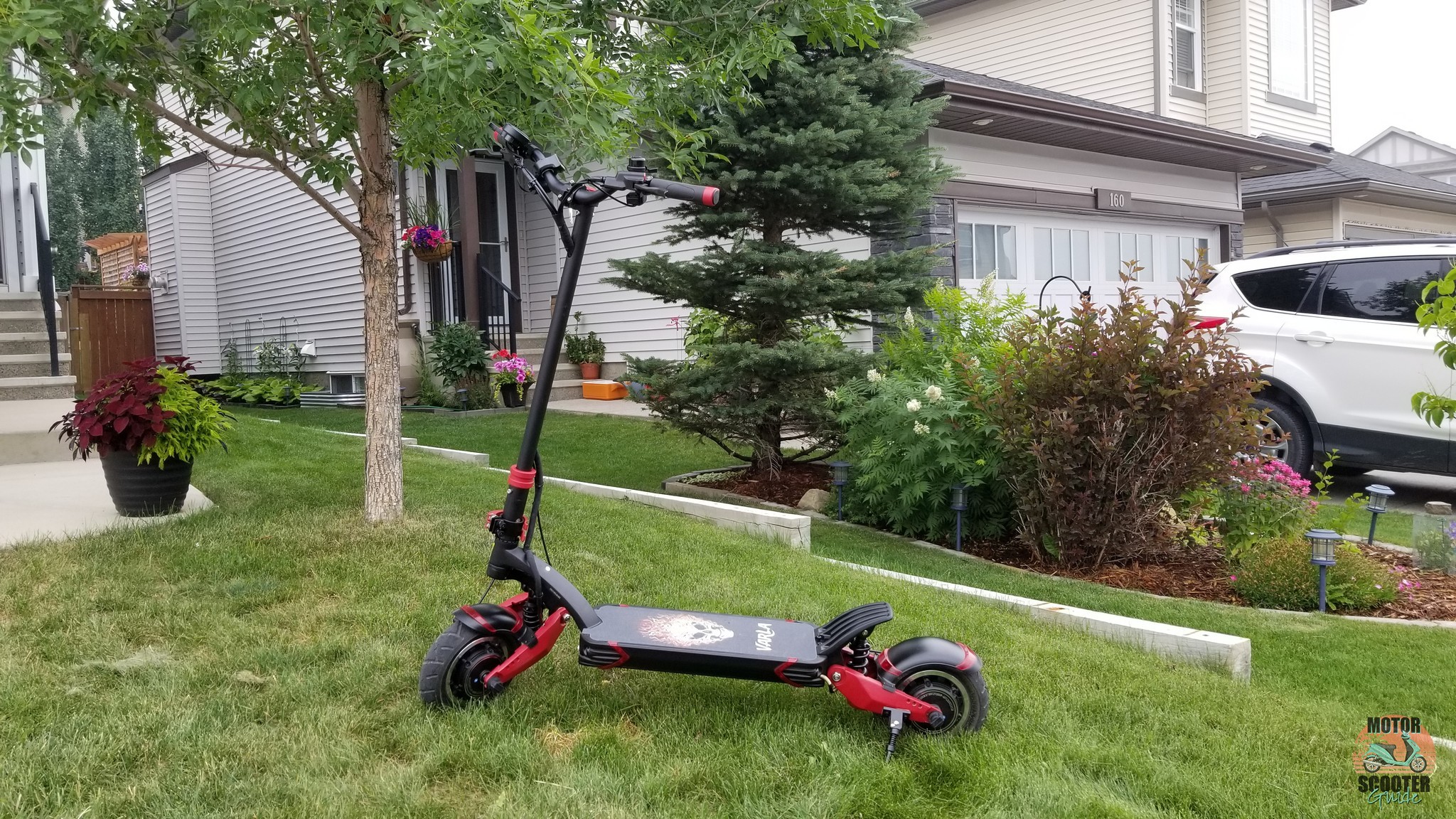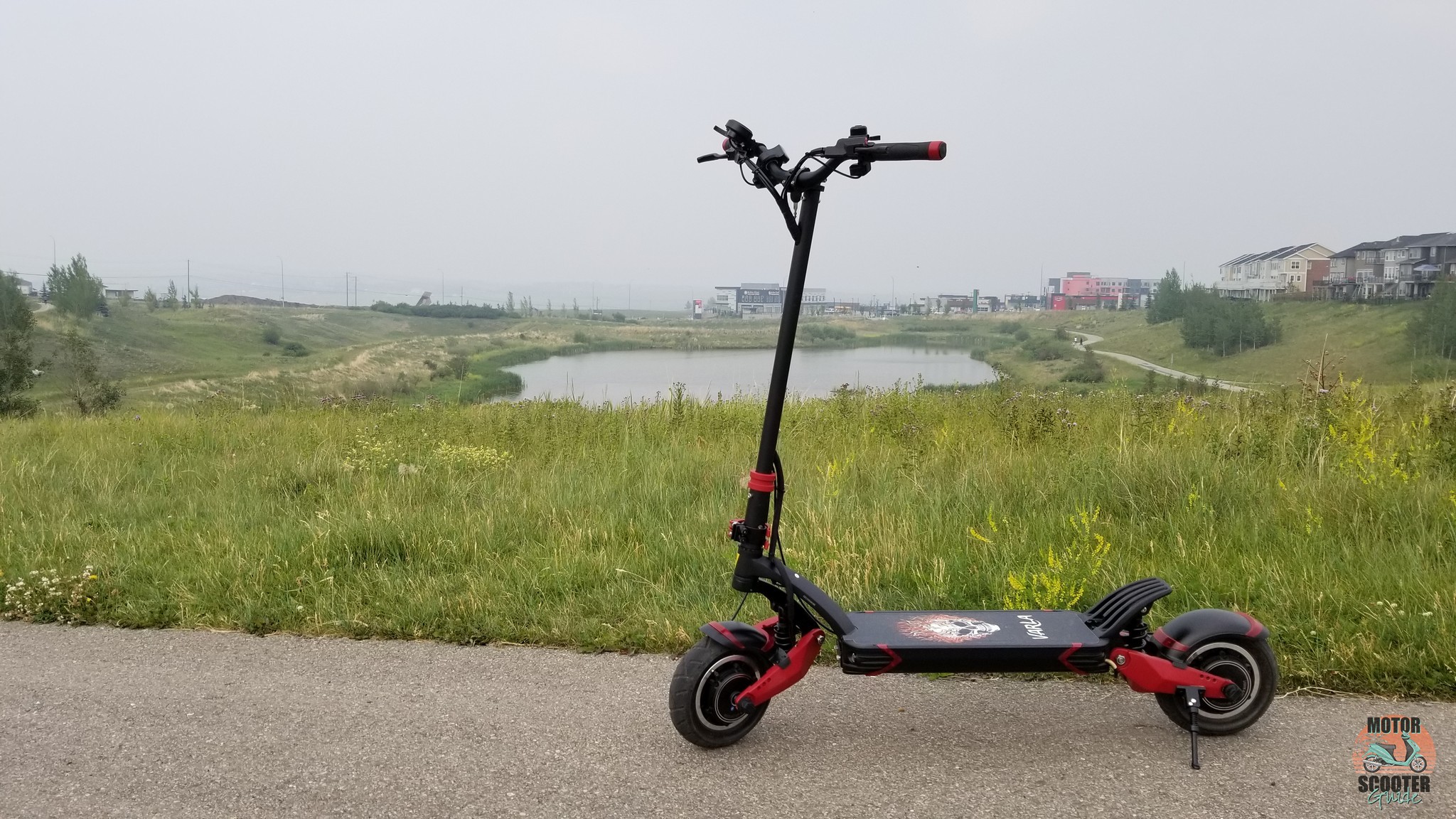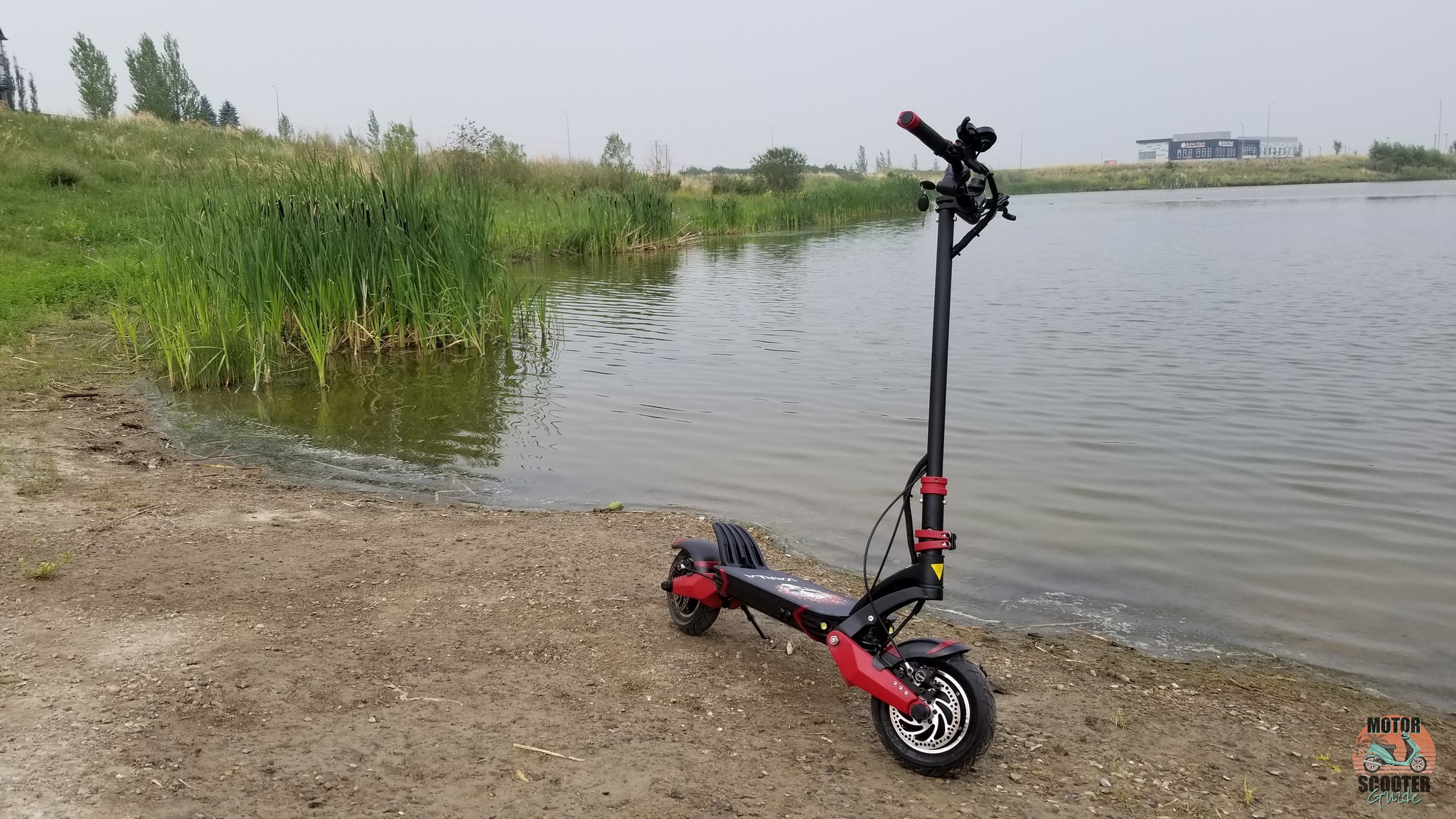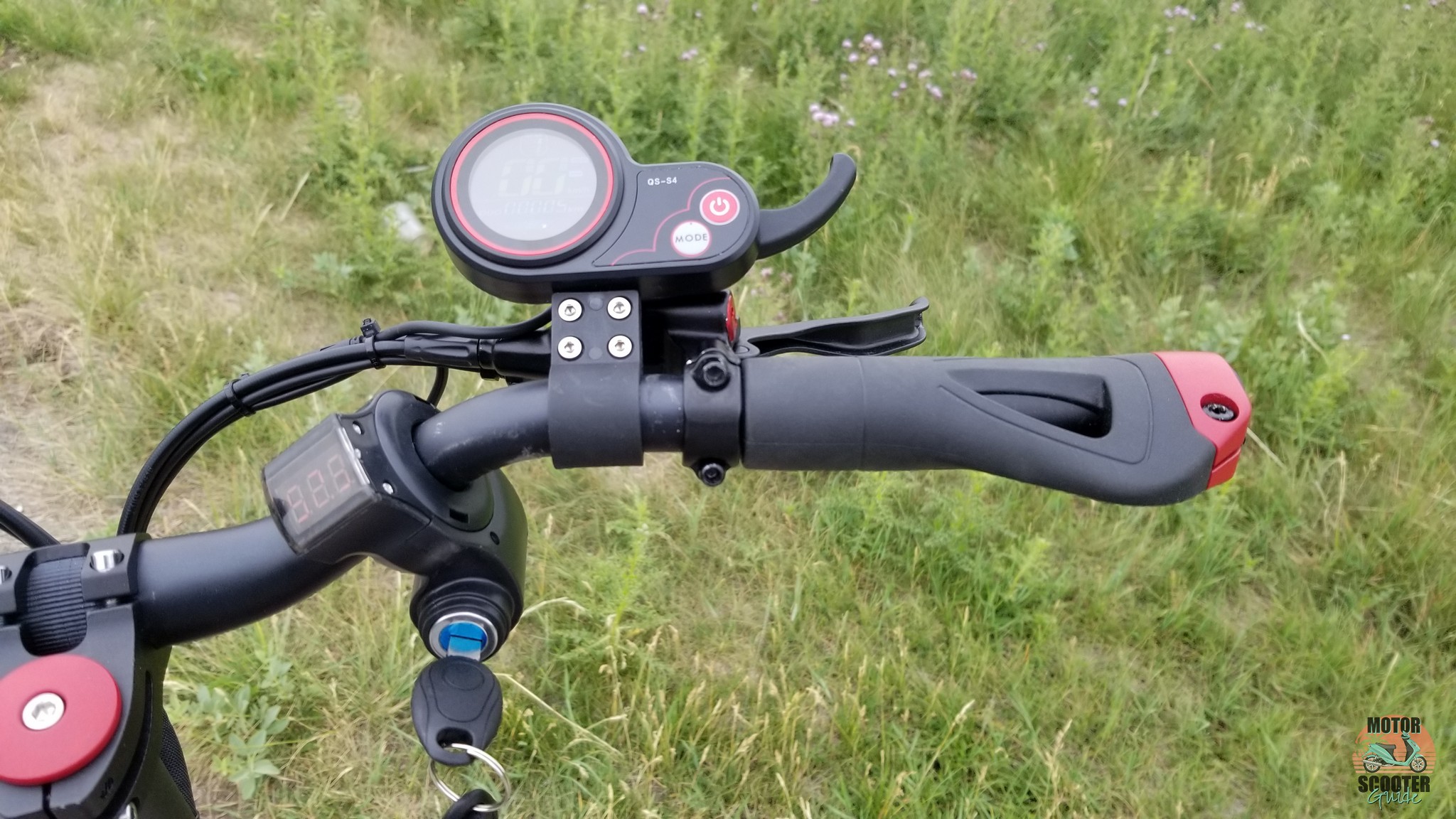Varla Scooters
We recently connected with Varla and they agreed to send their Eagle One off-road scooter for a long-term review.
Currently, Varla has two e-scooters in their lineup. The Pegasus, which is more of a commuter style ride, and the Eagle One which is the premium off-road model for the days you want to do even more exploring.
2021 Varla Eagle One Specifications
The Eagle One is equipped with the following features:
- Motor: Dual 1000w Hub Motor
- Battery: 52V/18.2Ah Lithium-ion battery
- Range: 40+ Miles / 64+ KM
- Top Speed: 40+ MPH / 64+ KMH
- Display: LCD backlight
- Brakes: Dual Hydraulic Brake + ABS
- Tires: 10 x 3 Inch Pneumatic Tires
- Weight (w/ battery): 35 kg / 77lb
- Charging Time: 8-9 hours (single 2.0A charger) and 4-5 hours (dual 2.0A charger)
- Waterproof Rating: IP54
Varla Eagle One Unboxing & First Impression
The Eagle One scooter was delivered in July, neatly packaged with no damage to the box. The total weight was a hefty 80lb. If it wasn’t obvious what an Eagle One is, the massive graphic stamped on the box left little to the imagination.
Varla had arranged for a signature on delivery and it also came a full week earlier than expected. Thanks, Purolator!
Like a kid on Christmas Day, it’s impossible to let a toy sit in its package so I got to opening it up. The box is sturdy and well assembled.
The Varla One comes mostly pre-assembled which makes for short work before the fun begins. The only steps left are the following:
- Unfold the handlebar stem
- Attach the handlebar
- Adjust and tighten the hand brakes, LED display, and bell
- Ensure that all nuts and bolts are tightened from factory
Damn, I can’t wait. Let’s get to it!
Varla Eagle One Assembly
The scooter is nicely packaged in styrofoam and the LED display is wrapped in softer material in order to protect it from scratches during unpacking.
The scooter comes with everything you need to assemble it, so nothing else is required. Check out the following video for a quick and easy guide on how to assemble the entire thing:
Handlebar Shaft
As mentioned, the first thing is to unfold and straighten the handlebar shaft, slide the locking mechanism down, and tighten it using the 2 levers. The two knurled knobs on the right side allow you to adjust how tight the fold clamps are when closing them around the shaft.
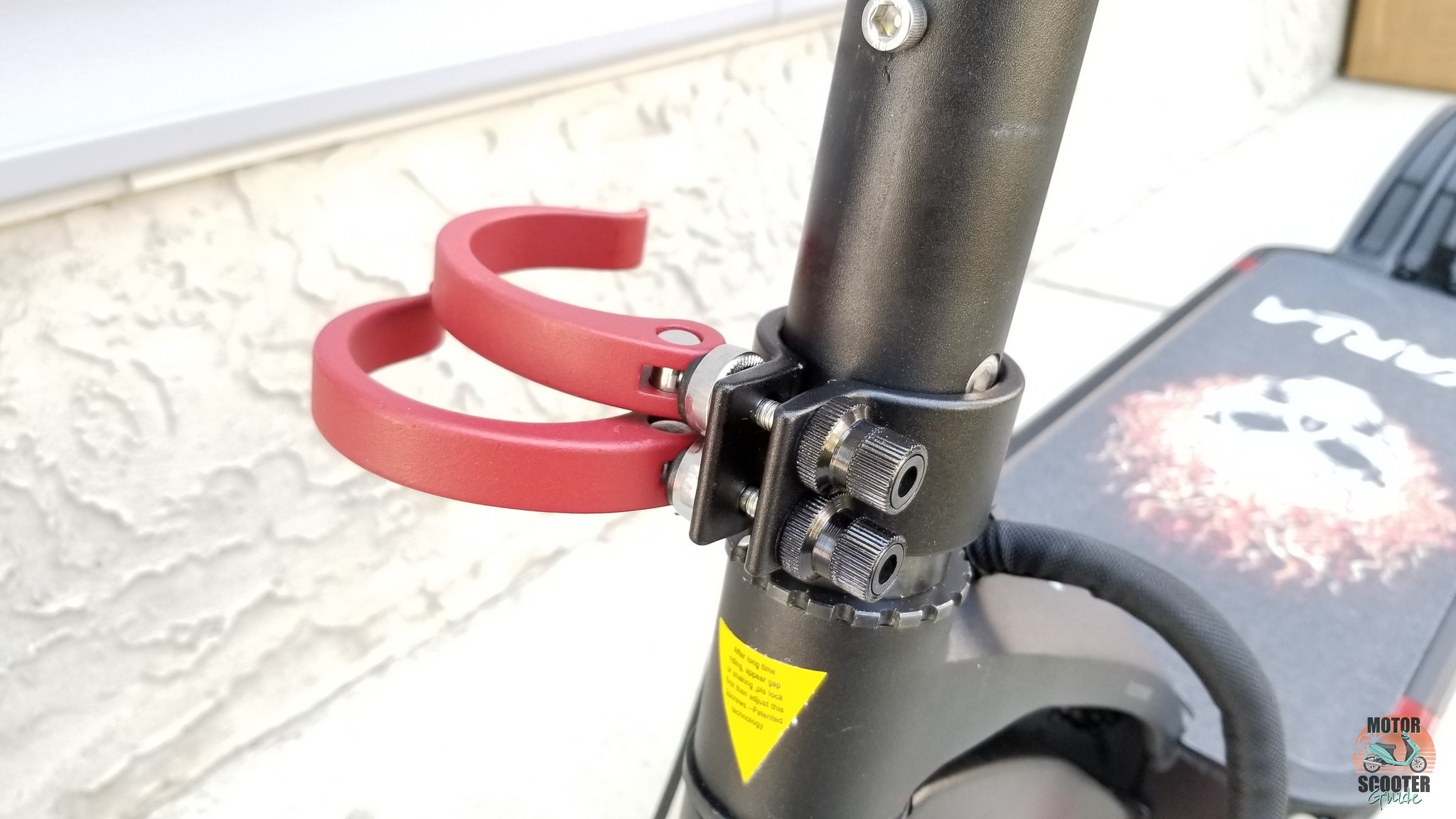
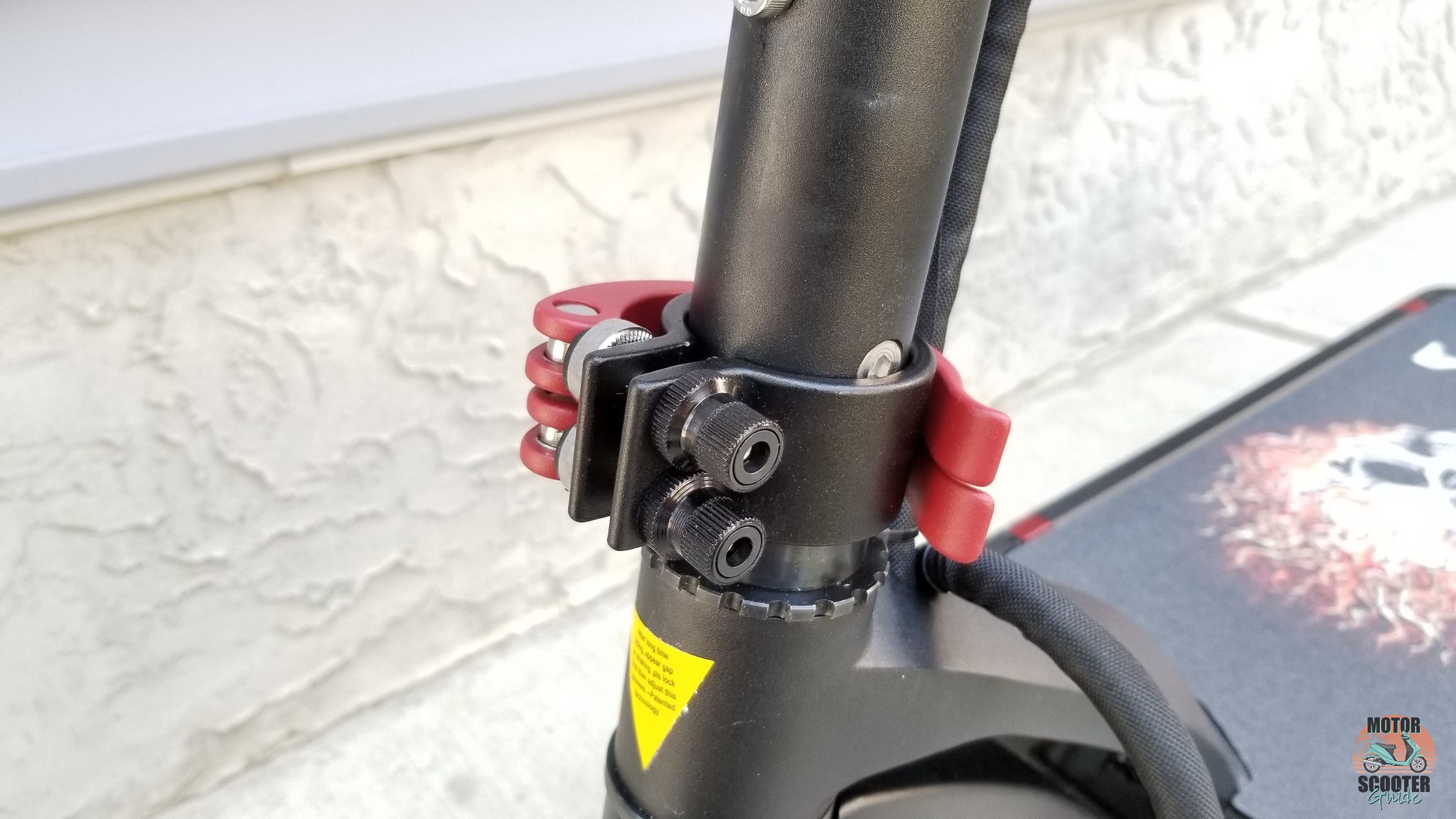
Handlebar Assembly
There are 4 hex screws that affix the handlebar to the shaft, so loosen them up with the provided tool, center your handlebar, and slowly tighten all 4 screws.
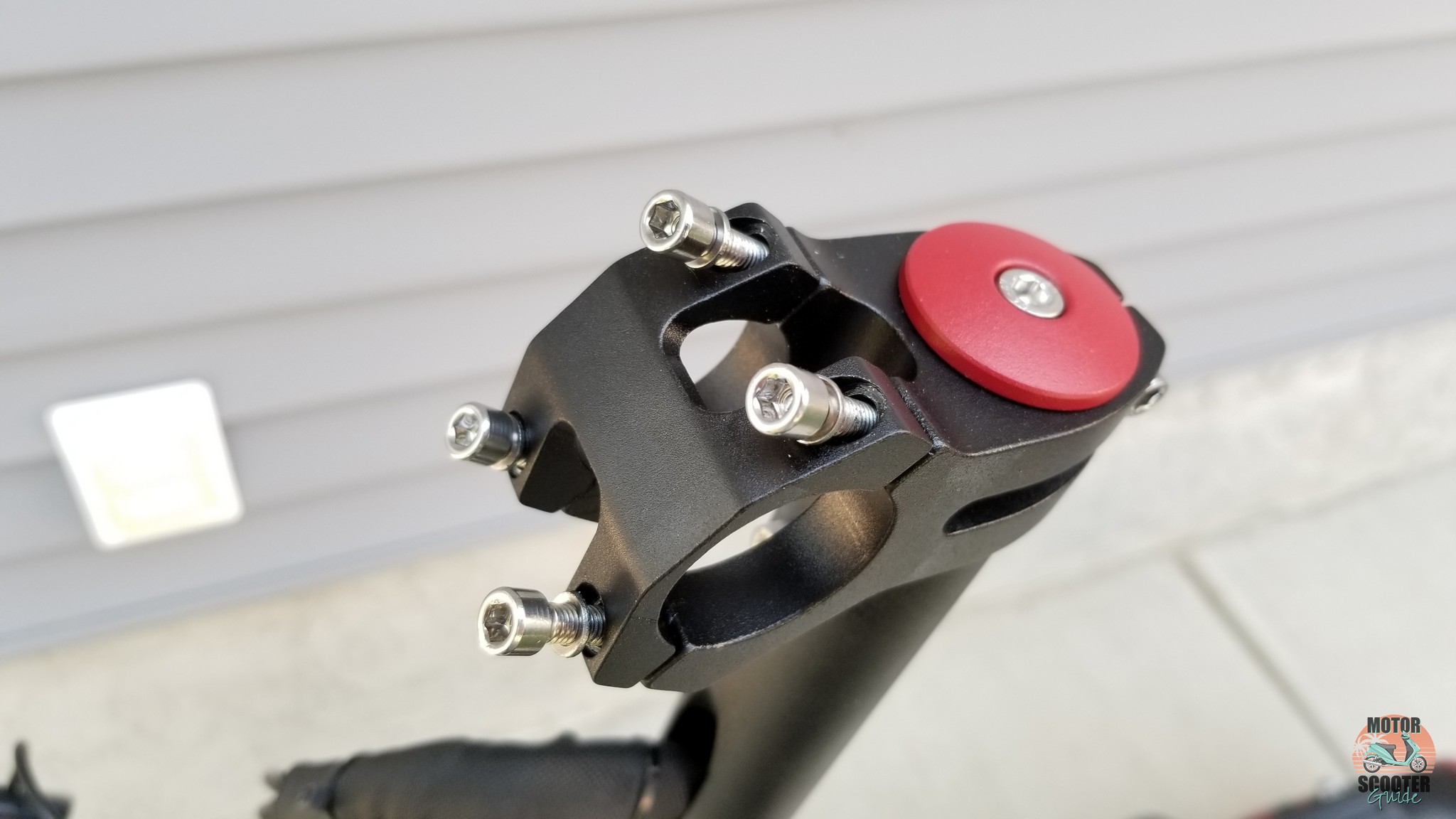
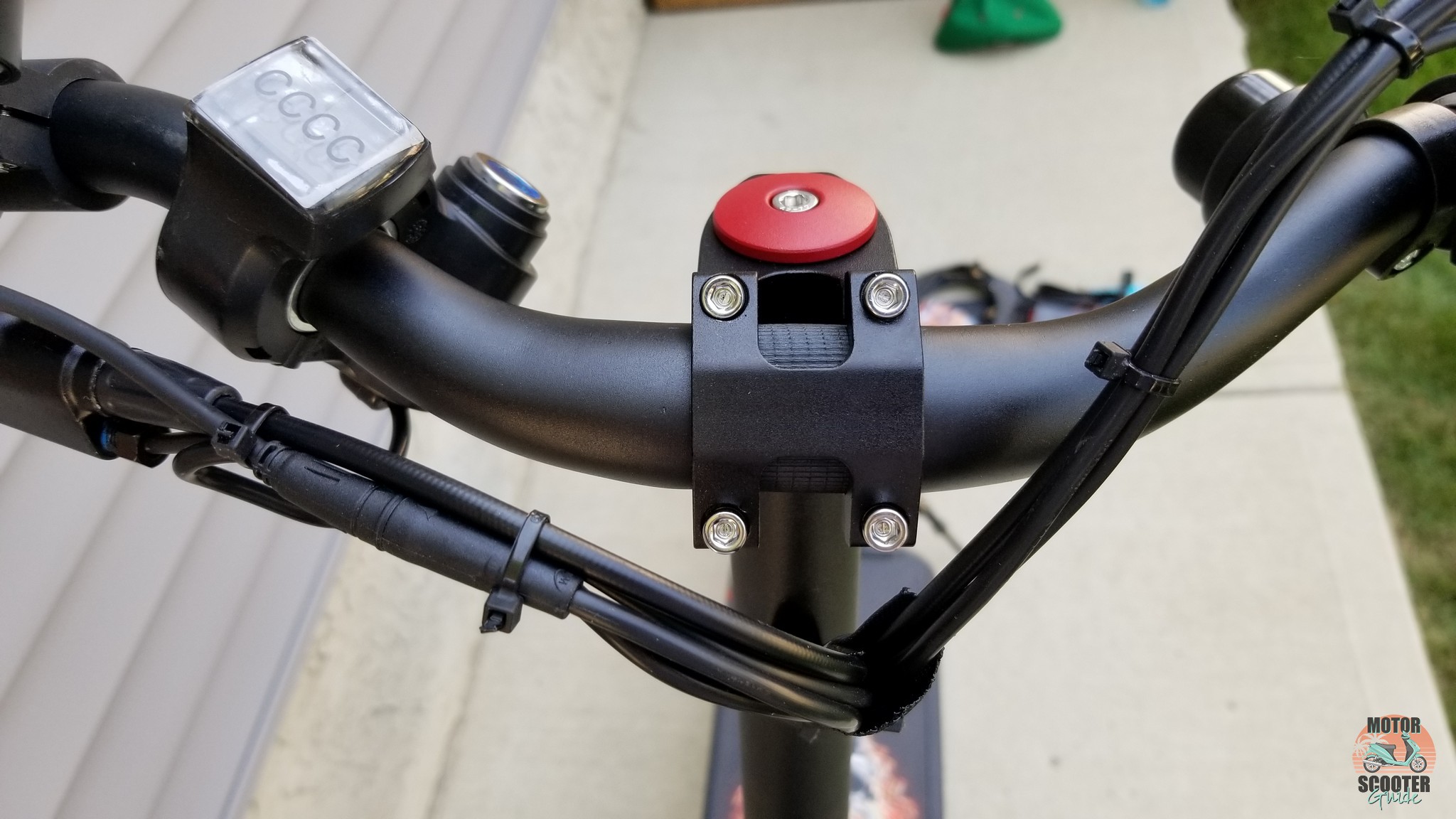
Once your handlebar is properly affixed, it’s time to move onto fine-tuning the various gadgets on the handlebars. This includes the left/right brakes, bell, key ignition, and the LCD display screen.
Gadget Adjustment
The Eagle One comes with a bevy of features including an LCD colour display, a key ignition, and a bell. Compared to other e-scooters on the market such as the Apollo Ghost and Mantis Pro SE, the addition of a bell is a nice touch as I frequently take it on pedestrian pathways. I’m not entirely convinced that the key ignition is a necessary feature being that the scooter has a weight of 77lb and serves as a minimal deterrent, as well as the availability of replacement keys on Varla’s website. A good bike lock would be a better investment.
These scooters go fast and you always want to be heard when approaching from behind, so be a safe rider and use that bell to announce yourself!
In the photo below, you can see that none of the gadgets have been adjusted. The left brake and LCD display/accelerator are situated too high. The bell is too low for my left thumb to reach.
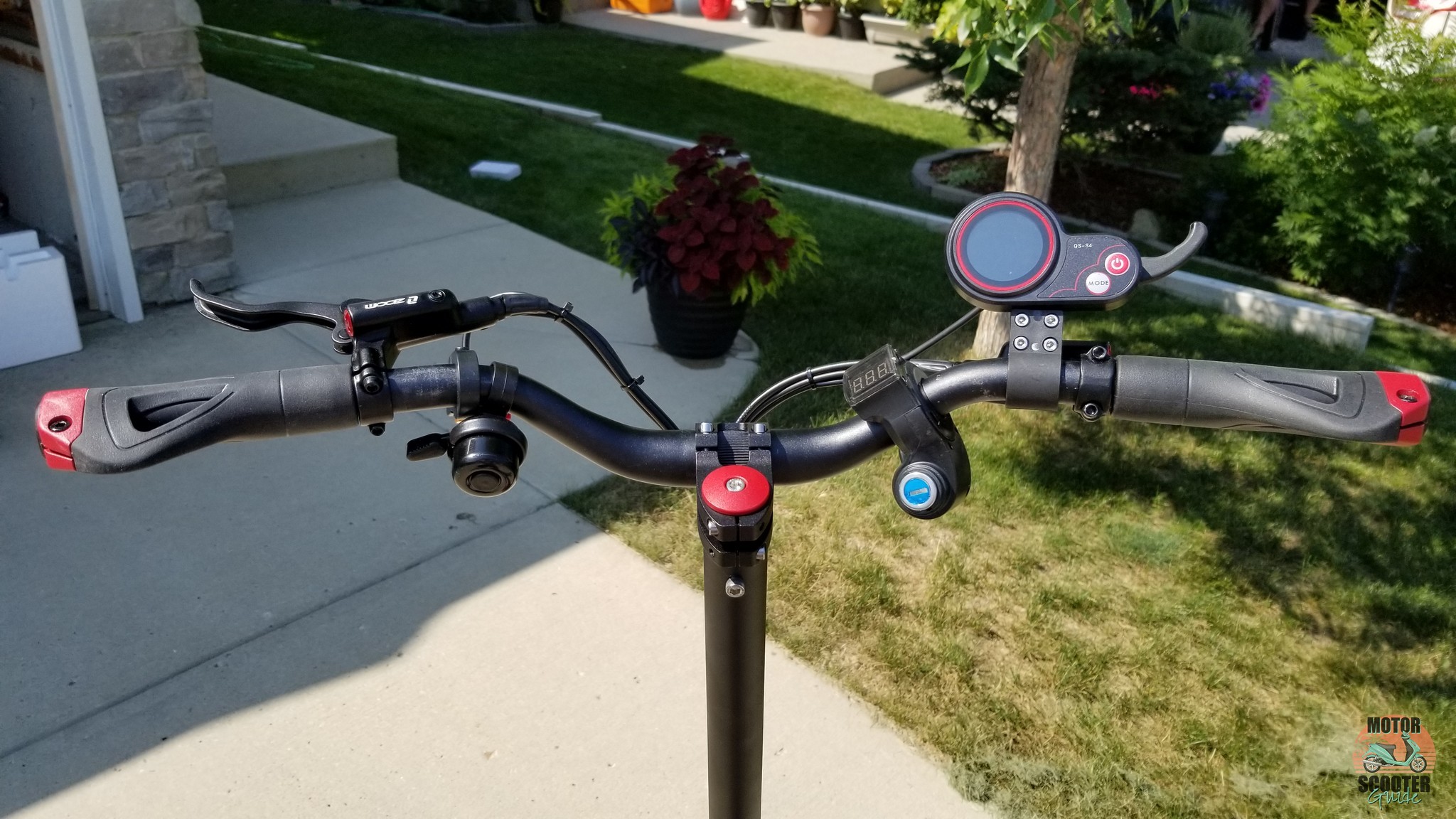
Lastly, you want to make sure that all the various nuts and bolts are secure as some may have loosened during the manufacturing process.
Varla Eagle One Box Contents
The Eagle One came with the following:
- User Guide Manual
- 2.0A Charger
- Assembly Tool
- Ignition key
- 3 extra deck grip tapes
- 2x replacement inner tire tubes
- 4x motor axel nut covers
For those who enjoy the extra swiggity swag and the desire to change up the aesthetic of their ride, the extra graphic deck tapes are sure to elicit a giggle.
Varla Eagle One Components
52V/18.2Ah Lithium-ion battery
The 52V/18.2Ah Lithium-ion battery is located on the underside of the scooter. I appreciate the larger 52V capacity as it helps deliver an estimated range of 40 mi / 64 km whereas the 48V battery on the Varla Pegasus is a 48V/15.6Ah.
Charging time is roughly 8-9 hours using a single 2.0A charger, but you can reduce the time by nearly half (4-5 hours) when leveraging the additional charging port if you opt to purchase a second charger.
Replacement batteries are also available through Varla should you ever need to swap one out.
Dual 1000w Motors
Powered by dual hub-mounted 1000w motors, the rear motor is engaged by default and you can toggle between a single or dual motor for additional power as needed.
This dual motor setup is powered by 2x25A speed controllers and can deliver a peak power output of 3200w, allowing riders up to 330lb and the ability to climb inclines of 30+ degrees.
LCD Display, Settings Menu, and Accelerator
The Eagle One comes with a QS-S4 LCD colour display that shows your odometer, speedometer, speed control mode, and battery levels. These settings are accessible on the right-hand side of the handlebar along with the trigger throttle.
There are 3 levels of LCD brightness and the speedometer can be toggled to show speed in kph or mph.
At the highest brightness level, the display remains relatively easy to read.
The owner’s manual also has a full list of P-settings which can be accessed by holding the Mode + Power buttons. These P-settings allow you to customize the odometer reading, acceleration, braking, max speed, and a variety of other features.
Varla recommends not adjusting certain settings so be sure to consult with the manual.
On the left-hand side, there is a yellow button that toggles between Eco and Turbo mode. Eco mode delivers smooth acceleration and extends the range while Turbo mode can be used if you’re wanting quicker acceleration.
The red button allows you to engage one or both of the hub-mounted motors.
These two options provide riders with the ability to customize their scooter’s configuration to suit their needs.
Lastly, the key ignition and battery voltmeter sit below the LCD display, which provides a reading of battery power.
All of the various settings can be read in further detail in the Owner’s Manual.
Tires, Brakes, and Suspension
Being an off-road scooter, the Eagle One is equipped with 10-inch pneumatic tires, Zoom hydraulic disc brakes, and shock suspension. There are hand-operated brakes on either side of the handlebar. The right-sided brake controls the front disc and the left-hand brake controls the rear disc.
While commuter-style scooters employ solid rubber tires and a lack of suspension, the off-road combination results in a smooth ride whether you’re on city roads or tearing it up on dirt roads.
The pneumatic tires and suspension greatly reduce the harshness of vibrations that you feel when traversing over rocks and bumps, while the dual hydraulic brakes and ABS (anti-brake system) allow you to stop on a dime. However, the downside of pneumatic tires is that they are vulnerable to punctures.
Varla recommends 40-45 psi for proper tire pressure and their accessories page also has a dedicated off-road tire.
Deck, Charging Port, and Front/Rear LED Lights
The Eagle One features a wide deck that measures 21” long by 9” wide. This open space allows the rider to comfortably adjust their footing as they’re cruising along and gives you a solid foundation for when you’re tackling the bumpy off-roads.
Located on the 4 corners of the deck are the LED headlights and taillights. You can toggle them on/off by holding the Mode button on the throttle controller for 3 seconds.
The rear LED lights are red and flash when applying the brakes allowing for other motorists on the road to be aware of your presence.
A Fully-Assembled Varla Eagle One!
The Eagle One was extremely easy to assemble and took less than 30 minutes. Most of the time was scrutinizing the various components of the bike and familiarizing myself with the LCD display and controller.
Let’s get to the riding!
The First Ride on the Varla Eagle One
Having ridden the Bird and Neuron scooters that are commonplace in downtown Calgary, I knew that this off-road scooter would be a different experience. One of the features that caught my interest early on was the max speed capabilities.
A max speed of 64km/hour? I’ve never been a speed demon, but I was excited to test out all three speed levels.
Varla instructs you to fully charge the Eagle One scooter before using it, but the LCD screen indicated that it had at least 75% battery capacity, so I skipped this step for a quick ride.
I live in the northwest suburbs of Calgary and had easy access to the walking paths nearby. The sky was dark and smoggy due to the inclement weather caused by forest fires in nearby provinces.
Imagine my surprise when I squeezed the throttle trigger because this scooter MOVES. The acceleration takes some getting used to but as aforementioned, you can fine-tune your experience by adjusting the P-settings.
As a 200lb/90kg rider, the Eagle One had no problems with acceleration whatsoever. I easily maxed out gear 1 (24kmh/15mph top speed), so I bumped it up to gear 2 which has a max speed of 25mph/40kmh.
It bears reiterating that you should always ride defensively and be considerate of others on the pathway meant for pedestrians. I wouldn’t recommend anything beyond gear 2 on walking paths especially if it has twists and turns with limited visibility.
As mentioned, the scooter uses the rear hub motor by default and toggling the red “dual” button engages the front motor as well. In order to maintain my speed and climb inclines, I frequently had to use the dual-motor function. The same goes with the yellow eco/turbo button. Acceleration is smooth in eco-mode but I much preferred the acceleration offered in turbo mode.
Why? Because vroom, that’s why.
The ride quality of the Eagle One is very comfortable due to the deck and the wide ergonomic handlebar grips. However, one of the downsides of the design is that the throttle trigger and the right-hand brake compete for space.
Both elements are equally critical for the rider so I had to make minor adjustments after several rides in order to find the perfect balance.
The brakes engage responsively and, like riding a bike, you have to be mindful not to apply the brakes over-aggressively lest you tumble over headfirst.
During the first ride, I took the Eagle One on paved paths, grass fields, as well as dirt paths. The scooter handled them all with ease and the combination of dual suspension, a wide deck, and a comfortable handlebar setup made for a silky smooth riding experience.
When I tell people the max speed (40mph / 64kmh) on this scooter, they’re always surprised. I’ve also been asked how they compare to e-bikes, such as the reviews we recently did on the Himiway Step-Thru and All-Terrain Cruiser, both of which are capable of high speeds. It’s a completely different experience due to the fact that you’re standing and not as secure on a bicycle. The full suspension on the Eagle One also gives the ride a completely different feeling and I can literally bounce off the curb in a jump.
The Long-Term Road Ahead
Thanks to Varla for providing us with this sample for review. This article is the first of many in our long-term review series. While the Varla Eagle One employs ubiquitous electronic scooter parts such as the QS-S4 throttle, this PEV offers immense value for those who are looking for a scooter that packs a punch while handling a variety of demanding environments.
I look forward to taking the Eagle One around the city as we continue to explore its capabilities.


